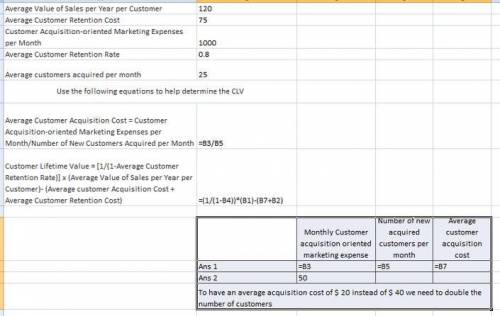
Business, 21.06.2021 16:30 abigail251
You are the owner of a smoothie shop in California. Afterhearing a podcast about customer relationship management (CRM), youdecide to gather more information regarding customer behavior inyour store to better understand the relationships that existbetween your business and your customers. CRM is a comprehensivebusiness model for increasing revenues and profits by focusing oncustomers. Customer Lifetime Value (CLV) is particularly importantwhen it comes to CRM and is often considered one of the mostcrucial metrics associated with a CRM system. Collecting data oncustomers and their relationships with a company (and commonlystoring it within a CRM system) helps make it possible to calculateCLV, or the total amount a customer will spend throughout theirrelationship with a company.
After a review and analysis of your customer data you are ableto determine the following information:
Average Value of Sales per Year per Customer: $120
Average Customer Retention Cost: $75
Customer Acquisition-oriented Marketing Expenses per Month:$1,000
Average Customer Retention Rate: 80%
You acquire an average of 25 new customers a month.
Use the following equations to help determine the CLV:
Average Customer Acquisition Cost = CustomerAcquisition-oriented Marketing Expenses per Month/Number of NewCustomers Acquired per Month
Customer Lifetime Value = [1/(1-Average Customer Retention Rate)] x(Average Value of Sales per Year per Customer)- (Average customerAcquisition Cost + Average Customer Retention Cost)
This activity is important because marketing managers need tounderstand and know how to calculate customer lifetime value as apart of customer relationship management. Knowledge of CLV caninform a number of critical marketing decisions related to suchfactors as the development of strategies designed to aid in theacquisition, nurturing, and retention of customers.
The goal of this exercise is to test your understanding of CLVby considering this example.
You must (1) complete the spreadsheet and (2) answer thequestions that follow to receive full credit for this exercise.

Answers: 3
Another question on Business

Business, 21.06.2019 15:20
The systems analysis phase includes three activities – requirements modeling, data and process modeling, and consideration of development strategies. choose two of these activities, explain their differences, and discuss how they are used to accomplish the main objective which is to understand the proposed project.
Answers: 1

Business, 22.06.2019 04:30
4. the condition requires that only one of the selected criteria be true for a record to be displayed.
Answers: 1

Business, 22.06.2019 04:40
What is ur favorite song and by who i know dis is a random question
Answers: 2

Business, 22.06.2019 06:50
On january 1, vermont corporation had 40,000 shares of $10 par value common stock issued and outstanding. all 40,000 shares has been issued in a prior period at $20.00 per share. on february 1, vermont purchased 3,750 shares of treasury stock for $24 per share and later sold the treasury shares for $21 per share on march 1. the journal entry to record the purchase of the treasury shares on february 1 would include a credit to treasury stock for $90,000 debit to treasury stock for $90,000 credit to a gain account for $112,500 debit to a loss account for $112,500
Answers: 3
You know the right answer?
You are the owner of a smoothie shop in California. Afterhearing a podcast about customer relationsh...
Questions



Biology, 10.06.2021 18:10



History, 10.06.2021 18:10

Mathematics, 10.06.2021 18:10

History, 10.06.2021 18:10


Mathematics, 10.06.2021 18:10

Mathematics, 10.06.2021 18:10


Mathematics, 10.06.2021 18:10




Mathematics, 10.06.2021 18:10



English, 10.06.2021 18:10


![= [1/(1-0.8)] x 120-(40+75)](/tpl/images/1380/3595/581cc.png)
![= [1/(1-0.9)] x 125 - (60+100)](/tpl/images/1380/3595/daaca.png)




